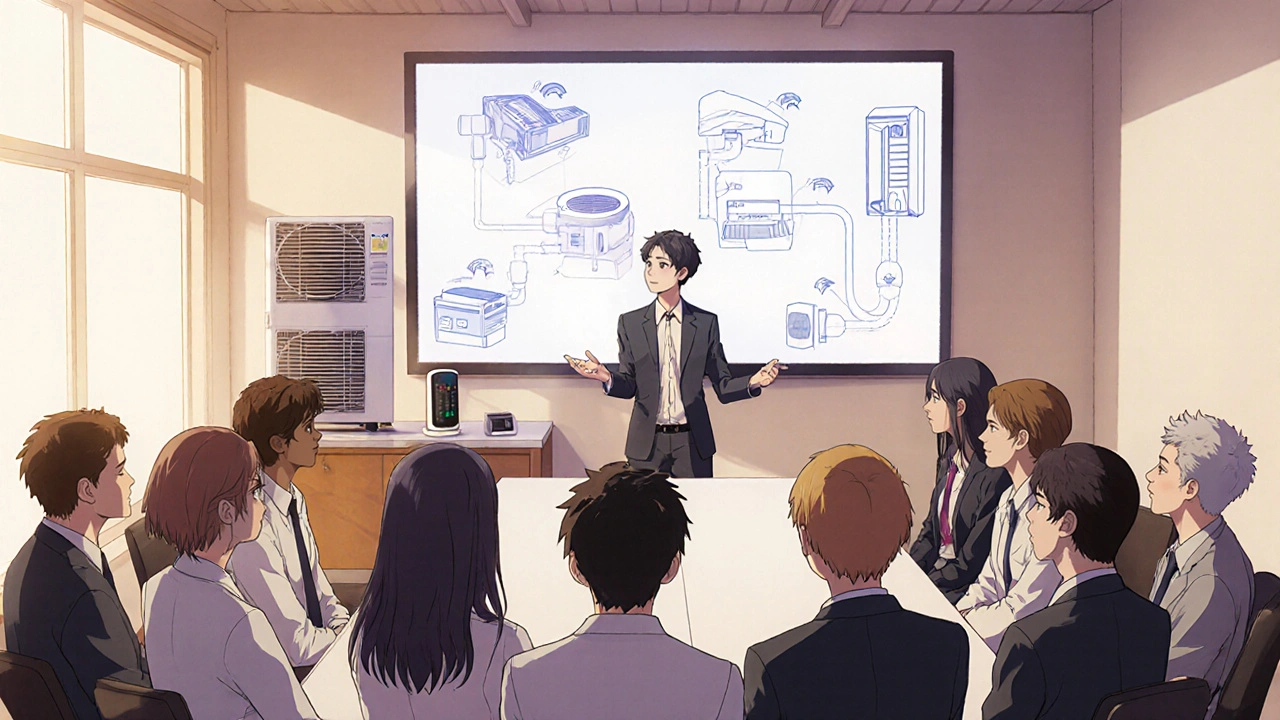When a worker with Asthma is a chronic respiratory condition that makes the airways swell and narrow, causing wheezing, shortness of breath and coughing, a sudden flare‑up at the office can feel like a race against time.
Quick Takeaways
- Identify and control common workplace triggers before they cause an attack.
- Keep rescue medication within arm’s reach and know how to use it.
- Set up a clear emergency action plan with coworkers and management.
- Use air‑quality monitoring and proper ventilation to reduce irritants.
- Regular check‑ups and spirometry keep your lung function in check.
Understanding Workplace Asthma
Asthma isn’t just a childhood ailment; adults can develop it or see existing symptoms worsen because of what they breathe at work. When asthma symptoms are triggered by substances encountered on the job, it’s called Occupational Asthma a form of asthma caused or aggravated by inhaling irritants, chemicals, or dust in the workplace. The condition accounts for roughly 15 % of adult asthma cases worldwide, according to a 2023 WHO report.
Knowing the difference matters. General asthma management works for everyday flare‑ups, while occupational asthma requires specific steps at the workplace - from adjusting your environment to notifying your employer about legal protections.
Common Workplace Triggers
Triggers can be obvious, like a strong perfume in a small office, or hidden, such as ultrafine particles from a printer. Below is a compact guide that pairs each trigger with a practical countermeasure.
| Trigger | Preventive Action |
|---|---|
| Dust and pollen | Regular cleaning, HEPA filters, keep windows closed during high pollen days |
| Cleaning chemicals | Use low‑VOC products, ensure proper ventilation, wear Personal Protective Equipment gloves, masks, or respirators designed to filter airborne irritants |
| Perfumes and scents | Implement a fragrance‑free policy, politely ask colleagues to avoid strong scents |
| Metal fumes (welding) | Install local exhaust ventilation, wear appropriate respirators, schedule breaks away from the source |
| Ink and toner particles | Place printers in a well‑ventilated area, use sealed cartridges, consider an Air Quality Monitor device that measures particulate matter (PM2.5) and volatile organic compounds |

Prevention Strategies
Prevention is a three‑step cycle: identify, mitigate, and monitor.
- Identify the irritants. Walk through your workspace with a notebook. Note any dust, strong smells, or equipment that releases fumes.
- Mitigate exposure. Simple fixes-like moving a printer to a separate room or asking facilities to replace carpet with vinyl-can cut particulate levels dramatically.
- Monitor air quality. A portable Air Quality Monitor gives real‑time data. When PM2.5 spikes above 12 µg/m³, open a window or trigger the HVAC system.
Speaking of HVAC, modern HVAC Systems Heating, ventilation, and air‑conditioning units that filter and circulate indoor air with MERV‑13 filters can capture most asthma‑triggering particles. If your building uses older filters, request an upgrade during the next maintenance cycle.
Emergency Action Plan
Even the best prevention can’t guarantee 100 % avoidance. That’s why an Emergency Action Plan a written procedure that outlines steps to take when a worker experiences an asthma attack is essential.
- Step 1 - Signal the emergency. Keep a small placard or badge that says “Asthma - need inhaler” so coworkers know to act fast.
- Step 2 - Use rescue medication. A quick‑acting Inhaler typically a metered‑dose inhaler (MDI) containing a bronchodilator like albuterol can bring symptoms under control within minutes. Keep it in a pocket, desk drawer, or at the office first‑aid kit.
- Step 3 - Call for help. If symptoms don’t improve after two puffs, dial emergency services and inform them of the asthma condition.
- Step 4 - Documentation. After the incident, note the time, trigger, and response. Share it with your occupational health officer to refine preventive steps.
Practice these steps during a low‑stress drill once a quarter. Repetition builds confidence for both the person with asthma and their teammates.

Managing Medication at Work
Many people think they have to hide their inhaler, but UK law under the Equality Act 2010 protects employees who need to keep medication on hand. Here’s how to make it hassle‑free:
- Store the inhaler in a clearly labeled, sealed container. A small zip‑lock bag works well.
- Inform HR or your line manager about the condition. Provide a doctor’s note if required.
- Consider a digital reminder app that logs each use. Over time, patterns can reveal hidden triggers.
For long‑term control, a Spirometry lung function test that measures the amount and speed of air you can exhale performed every six months helps adjust maintenance medication and gauge whether workplace changes are working.
Creating a Safer Environment
Safety isn’t one‑person work; it’s a cultural shift.
- Education. Host a short lunchtime talk about asthma triggers. Knowledge reduces stigma.
- Policy. Draft a “Clean Air Policy” that includes fragrance‑free zones, regular filter changes, and mandatory reporting of spills that could generate fumes.
- Facilities support. Work with building management to schedule HVAC maintenance during off‑hours to avoid disruption.
- Peer support. Pair up with a coworker who knows the emergency plan. A simple “Are you okay?” check‑in can catch early symptoms.
When these pieces click together, the result is a workplace where asthma attacks become rare, not inevitable. These tips are the backbone of effective workplace asthma safety.
Frequently Asked Questions
Can I legally keep my inhaler at my desk?
Yes. Under the Equality Act 2010, you have the right to store and use prescribed medication at work without discrimination.
What’s the difference between a rescue inhaler and a preventer?
A rescue inhaler (e.g., albuterol) works within minutes to open airways during an attack. A preventer (e.g., inhaled corticosteroid) reduces inflammation over weeks and lowers overall attack frequency.
How often should I test my workplace air quality?
At minimum, run a check at the start of each shift. For high‑risk settings, a continuous monitor that logs data every 5‑10 minutes is ideal.
What steps should I take if an attack starts at work?
Stop what you’re doing, sit upright, use two puffs of your rescue inhaler, then call a coworker or supervisor for help. If symptoms persist after 5‑10 minutes, call emergency services.
Can I request workplace modifications without losing my job?
Yes. Reasonable adjustments, such as better ventilation or a fragrance‑free area, are legal obligations for employers under the Equality Act.


I am a pharmaceutical expert with over 20 years of experience in the industry. I am passionate about bringing awareness and education on the importance of medications and supplements in managing diseases. In my spare time, I love to write and share insights about the latest advancements and trends in pharmaceuticals. My goal is to make complex medical information accessible to everyone.